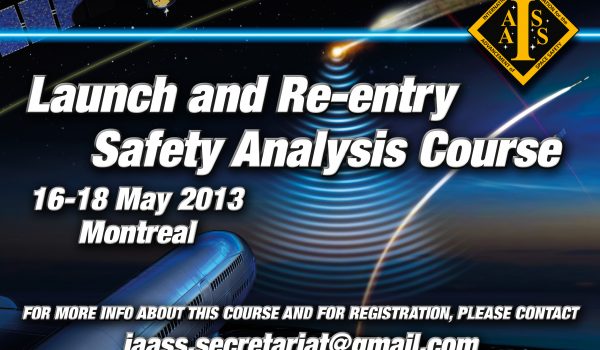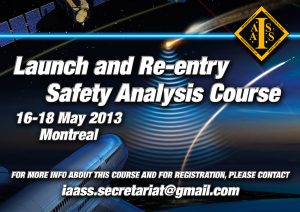
 The International Association for the Advancement of Space Safety is pleased to announce the upcoming Launch and Reentry Safety Analysis Course. The course will be held in Montreal, Canada on May 16-18, 2013 at 9:00 a.m.-5:00 p.m. EDT (GMT – 5 hours).
The International Association for the Advancement of Space Safety is pleased to announce the upcoming Launch and Reentry Safety Analysis Course. The course will be held in Montreal, Canada on May 16-18, 2013 at 9:00 a.m.-5:00 p.m. EDT (GMT – 5 hours).
About the Course
Over the last fifty years the methods for understanding and managing the risks associated with the launch and re-entry of space systems have evolved significantly. These advances have been driven by a combination of larger and more complex space boosters and decreased buffer between populated areas and launch sites. Improved risk management has resulted from increased computational capacity and more refined modeling. The result has been an outstanding record of protecting the public from the inherently dangerous operations of launching and re-entering of space systems.
This course teaches the principles of launch and re-entry safety analysis and risk management:
-Risk Concepts
-Risk Mitigation Concepts
-Mathematical and Statistical Principles
-Computation and Presentation of Risk
-Approaches to Risk Analysis Modeling
-Evaluating Catastrophe Risk
-General Launch Risk Analysis Procedure
-Impact Point Prediction and Impact Dispersions
-Impact Dispersions of Normal and
-Malfunctioning Vehicles
-Aircraft Probability of Impact and Vulnerability
-Impact Probabilities for Planned Jettisons
-Introduction to Debris List Development
-Failure Rate and Failure Mode Development
-Introduction to Exposure and Vulnerability
-Acceptable Risk
-Planned Re-entry Risk Analysis Methods
-Random Re-entry Risk Analysis Methods.
In addition this course is an enhanced version of the course first taught at US ranges and later in association with four previous IAASS conferences. Significant enhancements over the original course include:
a) Introduction to considerations of range safety system design,
b) Updated material on characterizing vehicle breakup,
c) Updated material on characterizing vehicle failure probabilities and response modes, and
d) An extended sample analysis integrated into the course.
Through this course, engineers and program managers with a solid engineering foundation will gain an understanding of the hazards associated with space flight, the data required to quantify the hazards, methods for quantifying the risks from these operations, and effective means for mitigating the risk from launch and reentry operations.
The following concepts will be learned:
• Approach to managing risks associated with launch and re-entry operations
• Definition of risk and risk measures (individual, collective, catastrophic);
• Process to perform quantitative flight safety risk analyses
• Sources of debris dispersion and methods of modeling
• Modelling impact probability distributions and computing probability of impacting people, buildings, ships and aircraft
• Consequence analyses: approaches to modelling vulnerability of people, structures, ships and aircraft and the consequences of impacting inert and explosive debris.
• Concepts for mitigating risk, such as mission/vehicle design, ship and aircraft management, and flight termination system design.
In summary, the participant will acquire an understanding of launch and re-entry flight safety analysis, requirements and techniques, and their significance for launch and re-entry approvals.
The course will be taught by Jerry Haber with support from Erik Larson and Randy Nyman. Mr. Haber has been the lead instructor for the previous IAASS courses. Mr. Haber has over 30 years of experience leading risk analysis model development efforts, developing risk acceptability standards, and performing flight safety risk analyses for the full spectrum of U.S. launch vehicles and missiles. He has developed guidelines for flight safety risk analyses for U.S. National organizations and a leader in the development of U.S. consensus risk acceptability standards for launch and re-entry risks. He analyzes the safety and risk mitigation strategies for a wide variety of launch and re-entry systems. He has developed methodologies that address the range of needs from screening analyses to detailed evaluations of complex systems. Mr. Haber is the author or co-author of numerous technical papers and reports. He has also co-authored the forthcoming Elsevier graduate level textbook Safety Design for Space Operations.
For More information about this course and for registration, please contact Mrs. Gonnie Elfering of IAASS at iaass.secretariat@gmail.com.

















































































































![A trajectory analysis that used a computational fluid dynamics approach to determine the likely position and velocity histories of the foam (Credits: NASA Ref [1] p61).](https://www.spacesafetymagazine.com/wp-content/uploads/2014/05/fluid-dynamics-trajectory-analysis-50x50.jpg)



Leave a Reply